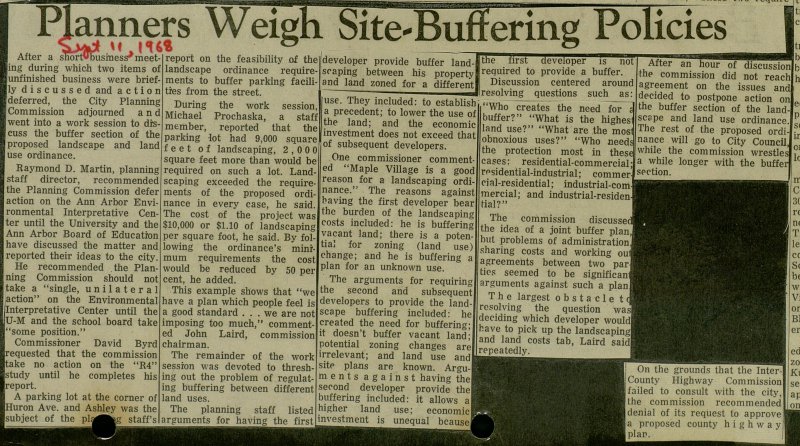Planners Weigh Site-Buffering Policies

After a short business meeting during which two items of unfinished business were briefly discussed and a c t i o n deferred, the City Planning Commission adjourned and went into a work session to discuss the buffer section of the proposed landscape and land use ordinance. Raymond D. Martin, planning staff director, recommended the Planning Commission defer action on the Ann Arbor Environmental Interpretative Center until the University and the Ann Arbor Board of Education have discussed the matter and reported their ideas to the city. He recommended the Planning Commission should not take a "single, unilateral action" on the Environmental Interpretative Center until the U-M and the school board take "some position." Commissioner David Byrd requested that the commission take no action on the "R4" study until he completes his report. A parking lot at the corner of Huron Ave. and Ashley was the subject of the planning staff's report on the feasibility of the landscape ordinance requirements to buffer parking facili tres from the street. During the work session Michael Prochaska, a staf member, reported that the parking lot had 9,000 square feet of landscaping, 2,000 square feet more than would be required on such a lot. Landscaping exceeded the requirements of the proposed ordinance in every case, he said. The cost of the project was $10,000 or $1.10 of landscaping per square foot, he said. By following the ordinance's minimum requirements the cost would be reduced by 50 per cent, he added. This example shows that "we have a plan which people feel is a good standard ... we are not imposing too much," commented John Laird, commission chairman. The remainder of the work session was devoted to threshing out the problem of regulating buffering between different land uses. The planning staff listed arguments for having the first developer provide buffer landscaping between his property and land zoned for a different use. They included: to establish a precedent; to lower the use of the land; and the economic investment does not exceed tha of subsequent developers. One commissioner commented "Maple Village is a good reason for a landscaping ordinance." The reasons against having the first developer bear the burden of the landscaping costs included: he is buffering vacant land; there is a potential for zoning (land use) change; and he is buffering a plan for an unknown use. The arguments for requiring the second and subsequent developers to provide the landcape buffering included: he created the need for buffering; it doesn't buffer vacant land; potential zoning changes are irrelevant; and land use and its plans are known. Arguments against having the second developer provide the buffering included: it allows a higher land use; economic investment is unequal because the first developer is not required to provide a buffer. Discussion centered around resolving questions such as: "Who creates the need for a buffer?" "What is the highest land use?" "What are the most obnoxious uses?" "Who needs the protection most in these cases: residential-commercial; residential-industrial; commercial-residential; industrial-commercial; and industrial-residential?" The commission discussed the idea of a joint buffer plan but problems of administration sharing costs and working out agreements between two parties seemed to be significant arguments against such a plan. The largest obstacle to resolving the question was deciding which developer would have to pick up the landscaping and land costs tab, Laird said repeatedly. After an hour of discussion the commission did not reach agreement on the issues and decided to postpone action on the buffer section of the landscape and land use ordinance. The rest of the proposed ordinance will go to City Council, while the commission wrestles a while longer with the buffer section. On the grounds that the inter-County Highway Commission failed to consult with the city, the commission recommended denial of its request to approve a proposed county highway plan.
Article
Subjects
Zoning
University of Michigan
Real Estate Development - Ann Arbor
Parking Structures
Ann Arbor Public Schools
Ann Arbor Planning Commission
Ann Arbor Environmental Interpretative Center
Ann Arbor City Council
Ann Arbor - City Planning
Ann Arbor - City Ordinances
Ann Arbor News
Old News
Raymond D. Martin
Michael Prochaska
John Laird